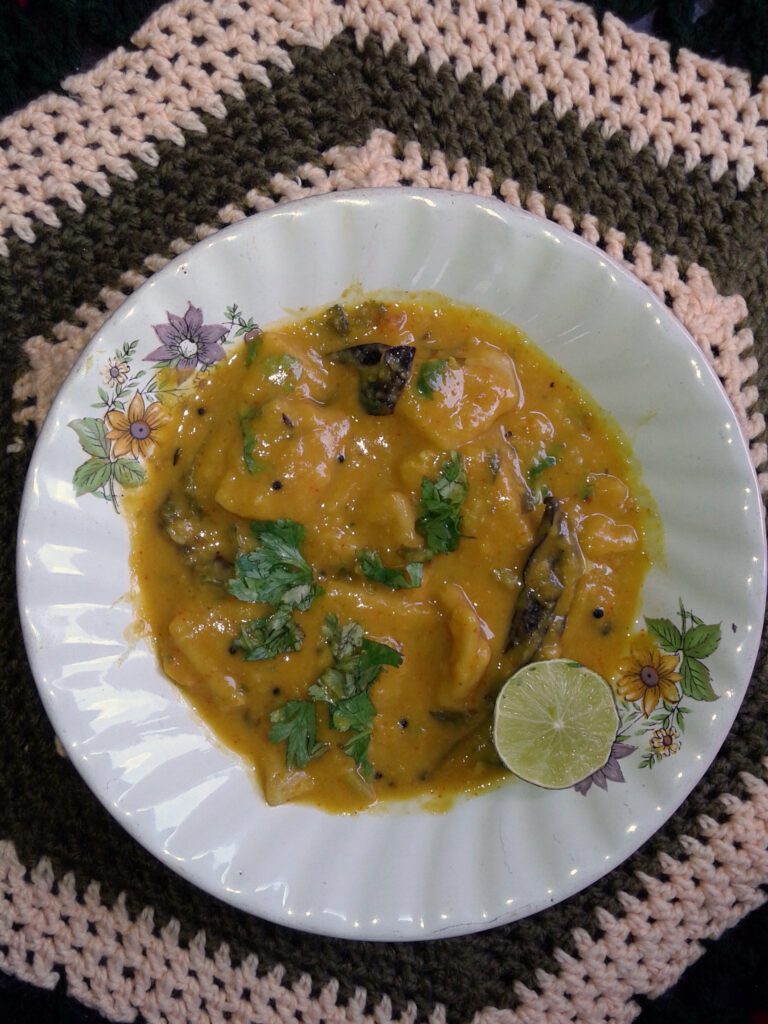Dal Dhokli is a traditional Indian comfort meal that mixes the flavours of lentil soup (dal) and spicy wheat flour dumplings. This substantial cuisine originated in Gujarat, but is now popular throughout India due to its wonderful taste and nutritious value. In this Dal Dhoki Recipe, we’ll look at Dal Dhokli’s rich history, ingredients, and cooking process, as well as present a full recipe for making this nourishing dish at home.Let us begin with Dal Dhokli Recipe.
Understanding Dal Dhokli’s Culinary Heritage
Dal Dhokli is a distinctive dish in Gujarati cuisine that is frequently cooked for festivals, festivities, and family gatherings. It’s a one-pot dinner with an ideal balance of protein, carbohydrates, and spices, making it both filling and nutritious. Dal Dhokli is traditionally cooked in a savoury lentil broth filled with aromatic spices, then served hot with a drizzle of ghee and a sprinkle of fresh coriander which you will see in this Dal Dhokli Recipe.
Dal Dhokli Recipe

Ingredients for Dal Dhokli Recipe:
For the Dhokli (Wheat Flour Dumplings):
1 cup whole wheat flour
1/2 teaspoon turmeric powder
1/2 teaspoon red chili powder
Salt to taste
Water, as needed
For the Dal (Lentil Soup):
1 cup tuvar dal (pigeon peas)
1 small onion, finely chopped
1 medium tomato, chopped
2-3 cloves of garlic, minced
1-inch piece of ginger, grated
1 green chili, slit lengthwise
1 teaspoon cumin seeds
1/2 teaspoon mustard seeds
1/2 teaspoon turmeric powder
1 teaspoon red chili powder
1 teaspoon coriander powder
Salt to taste
1 tablespoon oil or ghee
Fresh coriander leaves for garnish
Step by Step Guide for Dal Dhokli Recipe:
Step 1: Prepare the dhokli
In a mixing bowl, mix together the whole wheat flour, turmeric powder, red chilli powder, and salt.
Add water gradually and knead until the dough is firm but flexible.
Divide the dough into little lemon-sized balls and roll into thin discs.
Step 2: Prepare the dal
Rinse the tuvar dal completely before soaking it in water for 30 minutes.
In a pressure cooker, heat the oil or ghee and then add the cumin and mustard seeds.
When the seeds begin to sputter, add the chopped onions, minced garlic, grated ginger, and sliced green chilies. Sauté the onions until they become transparent.
Cook the diced tomatoes until they are mushy.
Drain the soaked tuvar dal and place it in the pressure cooker with turmeric, red chilli powder, coriander powder, and salt.
Add 3-4 cups of water and pressure cook for 3-4 whistles, or until the dal is tender.
Step 3: Add the dhokli
Once the pressure has released naturally, open the cooker and bring the dal to a slow boil.
Drop the rolled wheat flour discs (dhokli) into the boiling dal one at a time, making sure they do not stay together.
Cook the dhokli in the dal for 10-12 minutes, or until well cooked and soft.
Step 4: Garnish and serve
Garnish the Dal Dhokli with fresh coriander and a sprinkle of ghee.
Serve hot with rice or roti, or eat it on its own for a comfortable supper.

Cultural Significance: Discuss the cultural importance of Dal Dhokli in Gujarat and its role in festivals, family gatherings, and everyday meals. Highlight its popularity as a comfort dish and its capacity to unite people.
Health Benefits: Discuss the nutritional value of Dal Dhokli, emphasising the protein-rich dal, fiber-packed wheat flour dumplings, and the variety of spices used, which have antioxidant and anti-inflammatory qualities.
Regional Variations: Discover how Dal Dhokli is prepared and flavoured differently in different parts of India. Discuss any regionally distinct ingredients or cooking methods.
Tips and techniques: Provide helpful tips and techniques for preparing great Dal Dhokli, such as how to adjust the dal consistency, substitute components for the dhokli dough, and creative garnishing ideas to improve presentation.
Accompaniments: Provide suggestions for accompaniments that pair well with Dal Dhokli, such as tangy pickle, crunchy papad, or refreshing raita. Include recipes or links to complementary dishes for readers to try.
Storage and Reheating: Share how to store leftover Dal Dhokli and reheat it for future meals. Provide tips on how to keep the flavour and texture intact after reheating.
Family Stories or Traditions: Share personal anecdotes, family stories, or cultural traditions related to Dal Dhokli. Encourage readers to add their own experiences or recollections of eating this dish with loved ones.
Serving Suggestions: Make unique serving suggestions for Dal Dhokli, such as using traditional brass or copper utensils or arranging it with colourful garnishes for a visually appealing display.
Dal Dhokli is more than simply a meal; it’s a gourmet experience that highlights the rich flavours and textures of Indian cuisine. By following this precise Dal Dhokli Recipe., you may make this traditional dish in your own kitchen and enjoy the warmth and comfort it provides with each bite with the help of this Dal Dhokli Recipe. So gather your supplies, roll up your sleeves, and prepare for a tasty journey with Dal Dhokli with this Dal Dhokli Recipe!
You can also try some Quick and Delicious Pasta Recipe: 30-Minute Pasta Recipes for Busy Nights.
Pingback: Indian Cabbage Recipes for Delicious and Healthy - 2024